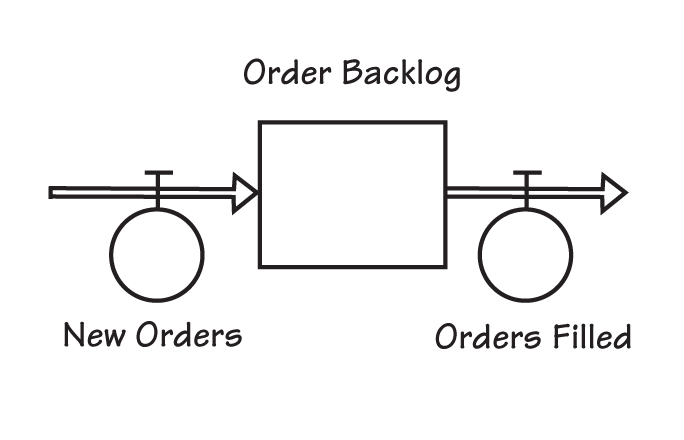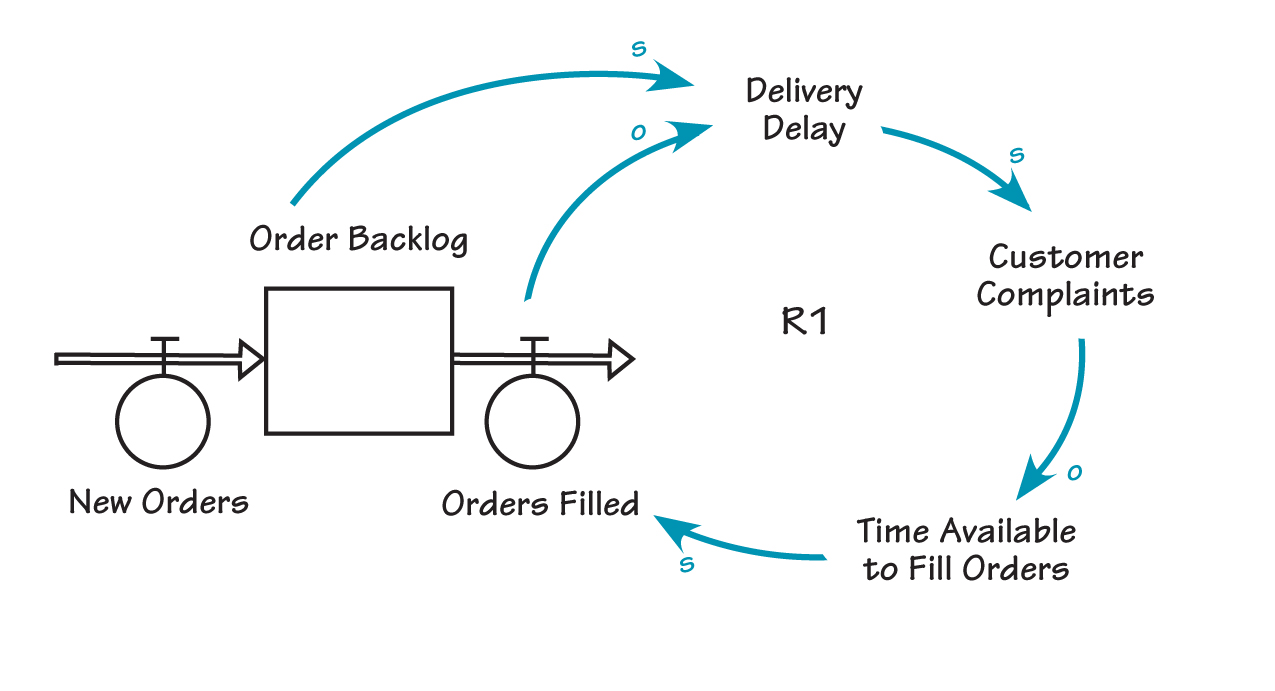A common principle of systems thinking is that “there is no away.” Every material thing we make and use must come from somewhere and must go somewhere. As obvious as this sounds, it can be easily overlooked in a culture with a “throw away” mentality. Seeing the world in terms of accumulators (or stocks) and flows forces us to be more conscious of the full supply chain—both the source and depletion of materials. Looking at organizational issues from an accumulator and flow perspective can help us look at the “big picture” by identifying the source of problems rather than just the symptoms.
Characteristics of Accumulators and Flows
 Accumulators and flows are basic building blocks that allow us to represent dynamic phenomena in a more precise way than systems archetypes and causal loop diagrams (see “Accumulators: Bathtubs, Bathtubs Everywhere…” V21N7). Accumulators are things that accumulate over time—water in a bathtub, interest in an IRA account, world population—and are represented in accumulator and flow diagrams by a box. Flows, on the other hand, are things that increase or decrease the levels of an accumulator—water flowing in or out of the bathtub, money flowing in or out of an IRA, births and deaths affecting population—and are represented by a circle with a faucet on top.
Accumulators and flows are basic building blocks that allow us to represent dynamic phenomena in a more precise way than systems archetypes and causal loop diagrams (see “Accumulators: Bathtubs, Bathtubs Everywhere…” V21N7). Accumulators are things that accumulate over time—water in a bathtub, interest in an IRA account, world population—and are represented in accumulator and flow diagrams by a box. Flows, on the other hand, are things that increase or decrease the levels of an accumulator—water flowing in or out of the bathtub, money flowing in or out of an IRA, births and deaths affecting population—and are represented by a circle with a faucet on top.
 TIP: One way to differentiate between accumulators and flows is by their measurement: accumulators are measured in units, while flows are measured in units over time. Money saved in an IRA, for example, is measured in dollars, while the interest flow is measured in dollars per year.
TIP: One way to differentiate between accumulators and flows is by their measurement: accumulators are measured in units, while flows are measured in units over time. Money saved in an IRA, for example, is measured in dollars, while the interest flow is measured in dollars per year.
Understanding accumulator and flow structures is important because almost all complex dynamic behavior in organizations occurs as a result of accumulations of material or informational flows. Identifying accumulators, therefore, focuses our attention on managing the most important variables in a system. At the same time it helps us understand how our decision-making process can regulate the flows into and out of those variables.
Filling Orders as Accumulators and Flows
Mapping a system in terms of accumulators and flows can help us visually represent the structure of a system and identify the source of problems. If we are experiencing a growing backlog of unfilled orders, for example, we might begin sketching out the system by identifying the most visible accumulations in our order fulfillment system. “Order Backlog” would be an obvious starting point. If we then asked how the accumulation of our order backlog could be changed, we might identify flows such as “New Orders” (which increase the backlog) and “Orders Filled” (which decrease the backlog).
 From this simple accumulator and flow diagram, we can next flesh out the picture and add detail using our understanding of past history. For example, if the order backlog remains high, delivery delays usually go up. Customers will grow impatient and may threaten to take their business elsewhere. One way to respond to this problem is to expedite certain orders—which pleases angry customers, but also takes time away from order fulfillment and leads to an increase in the order backlog and more angry customers (R1). This series of events can be captured by adding a causal loop to our initial accumulator and flow diagram (see “Impact of Order Backlog”).
From this simple accumulator and flow diagram, we can next flesh out the picture and add detail using our understanding of past history. For example, if the order backlog remains high, delivery delays usually go up. Customers will grow impatient and may threaten to take their business elsewhere. One way to respond to this problem is to expedite certain orders—which pleases angry customers, but also takes time away from order fulfillment and leads to an increase in the order backlog and more angry customers (R1). This series of events can be captured by adding a causal loop to our initial accumulator and flow diagram (see “Impact of Order Backlog”).
Viewing the situation from an accumulator and flow perspective makes it clear that there are only two ways to reduce the backlog—decrease the inflows or increase the outflows. We either have to slow down or stop marketing for a while, or ramp up capacity to increase the order fulfillment rate. The accumulator and flow diagram poses the situation in a clear and concise way and focuses our attention on addressing the key flows.
IMPACT OF ORDER BACKLOG

If the order backlog remains high, delivery delays usually go up. Customers will grow impatient and may threaten to take their business elsewhere. One way to respond to this problem is to expedite certain orders—which pleases angry customers, but also takes time away from order fulfillment and leads to an increase in the order backlog and more angry customers (R1).
Accumulators as Memory
Mapping in terms of accumulators and flows reminds us that accumulators don’t simply disappear just because we stop a particular flow. If, for example, we were to stop all marketing efforts today, it would still take time for orders from previous marketing campaigns to stop flooding in, which means we need to address our capacity issues regardless of how we change our marketing efforts. When managing an accumulator and flow structure, it is important to remember that accumulators are a little like elephants—they never forget what they have been given to remember.
Kellie T. Wardman is resource director of YMCA of the USA. Kellie was publications director of Pegasus Communications. She holds an MFA in creative writing from Emerson College. Go to her blog at http://kelliewardman.com.
Daniel H. Kim is co-founder of Pegasus Communications, founding publisher of The Systems Thinker newsletter, and a consultant, facilitator, teacher, and public speaker committed to helping problem-solving organizations transform into learning organizations.
